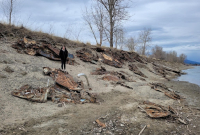Support strong Canadian climate journalism for 2025
These in-their-own-words pieces are told to Patricia Lane and co-edited with input from the interviewee for the purpose of brevity.
Usman Khan wants spongier cities. This associate professor at the Lassonde School of Engineering at York University works with communities to design and build urban landscapes to make them more resilient to flooding, cooler in summer and healthier for our minds and bodies.
Tell us about spongier cities.
I love city life and most people live in urban areas. As frequent flooding and global heating threaten our well-being, we have wonderful opportunities to rethink urban infrastructure to improve city life, especially in lower-income communities.
Engineers must design with the risk of flooding in mind. But my research shows that if we also design with the concept of rain as a precious resource and plan to soak it up, floods will do less damage. These design ideas bring many co-benefits including cooling spaces in hot summers, cleaner air and healthier bodies, resilient food and flower gardens and access to more green space, which is accepted as beneficial for our mental health.
This is well understood in wealthy communities where the natural environment is part of the plan to soak up rain and keep residents cool. But climate change-induced flooding and heating are now imperilling the lives and well-being of people who live in communities that have not had this kind of consideration. As we rebuild some of this infrastructure, either after major weather events or hopefully in anticipation of them, thinking about rain and nature differently can do much to keep people safe and improve the quality of their lives.

How did you get interested in this work?
Ten years ago, I was living in Calgary when a major flood of the Bow River destroyed many lovely homes along its banks. I wondered if the care that went into the restoration would have been present if the homes had not been so expensive.
Where are cities getting spongier?
Berlin and Vienna have had major retrofits. Toronto now requires all new buildings of a certain size to have a green roof and new parking lot surfaces must be permeable. I see municipalities replacing concrete traffic-calming blocks with tree boxes and Vancouver and Montreal are embracing rain gardens.
What makes it hard?
Civil engineering is an old profession and many things have been done a certain way for a long time. It is hard to hear people say these things have not been proven to work when the evidence is clear, or to dismiss long-term improvements in health and well-being in favour of cutting costs in the short term, especially when the old approaches are creating tragic and expensive disasters. I feel impatient with misplaced priorities when we could improve our cities.

How did the way you were raised affect your thinking?
When I was a small child, we lived in the United Arab Emirates where it rarely rains. One day it did. My sister and I ran outside to feel it. I was so curious when I came to Canada and saw how differently rain is experienced here.
Perhaps it is not that surprising that, as an undergraduate, I designed a net-zero water-use building. I am also very interested in using big data to improve water quality and am very proud of the work my team has done in that regard in large refugee camps by developing the Safe Water Optimization Tool.
What gives you hope?
In a perverse way, the number of climate events we have suffered this year may have been the attention-getting mechanism we need.
What do you see if we get this right?
More happiness that comes from trees and greenery on every city block everywhere.
What would you like to say to young people?
I have mixed feelings. I have the privilege to design my life so that it has low emissions, but personal responsibility can only take us so far. It must not become a distraction from creating the political will to make the changes we need fast enough.
![Usman Khan with graduate students and colleagues on a research trip to Egypt to study the effects of climate change on ancient Egyptian structures. Photo submitted by Usman Khan]](/sites/default/files/styles/scale_width_lg_1x/public/img/2023/11/01/khan_05_0.jpg?itok=EHNSObQZ)
What about older readers?
Encourage the young people in your life to pursue their ideas. Your support matters more than you know.







Comments
Try as I might to look on the bright side, I just can’t find a redeeming value in this in-their-own-words series.
Some comments on this latest one.
“[M]y research shows that if we also design with the concept of rain as a precious resource and plan to soak it up, floods will do less damage.”
I think it long been known, since well before the guest was even born, that facilitating the ground-absorption of water reduces flooding; I don’t think it was his research that illuminated that particular lightbulb. Whether that’s in a constructed environment or in a natural landscape. A further observation is that, to my knowledge, floods rarely occur solely from rain that falls within an urban boundary. Sure, we get very short-term, micro-flooding from a passing thunderstorm, but I ask you to point out a major flood event that occurred from local rainfall only. Serious urban flooding, rather than the briefly disruptive variety that fills a dip in a city street for a few hours, is something that originates beyond the borders of a town. I’m surprised the guest didn’t allude to that. In BC, for example, what effect has the extraction of forest cover had on flooding due to the much-reduced capacity of denuded, and subsequently dried-out forestland to absorb and retain water? And, while the guest mentioned his experience with the floods in Calgary, and area, a decade ago, he didn’t mention that flooding is a natural state for rivers, such as the Bow, and that much flood damage is self-inflicted because we (continue to) choose to build on flood plains, such as along the Bow and Elbow in Calgary (or along the Ottawa and the Gatineau in... well... you know). What should we expect but floods?
“This is well understood in wealthy communities where the natural environment is part of the plan to soak up rain and keep residents cool.”
What “plan” is the guest referring to? Here I thought that the wealthy just like having a big chunk of land. Although, I have noticed that some wealthy neighbourhoods comprise McMansions built to lot lines with very little greenspace to soak up the rain. I wonder what percentage of such properties drain the rainfall from rooftops into underground cisterns for absorption vs. directing it to city street catchments. Further, in my cruising around town, I notice that many new exurban “estate” developments are merely grass fields, with a big-ass house in the middle and a few trees scattered here and there. Hardly a showcase of environmental awareness and ambition. And there is no linking, in the article, the water absorption to the stated cooling effects, so we are left to assume it is so. And what sort of cooling? Ambient air? Ground temperature? Interior temps? Thought I’m aware of the significant cooling effects of tree cover (which, of course, needs water), I’m unaware or such cooling effects from just water absorption.